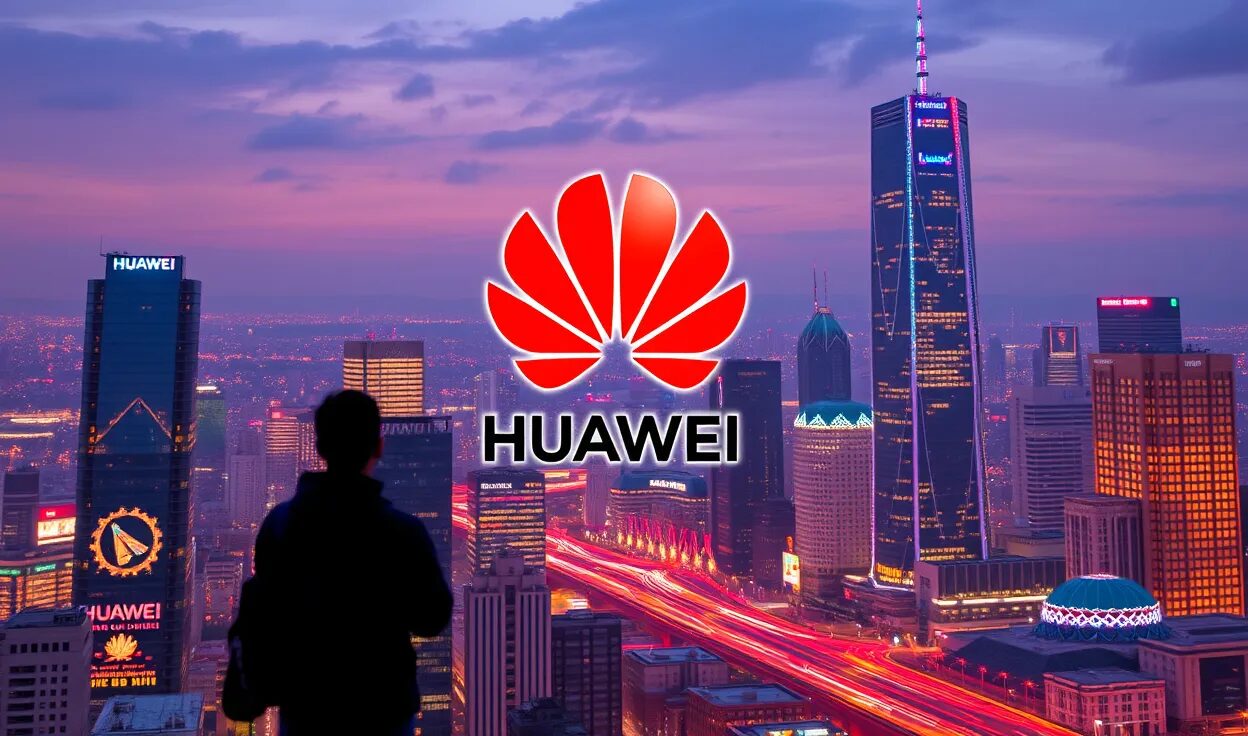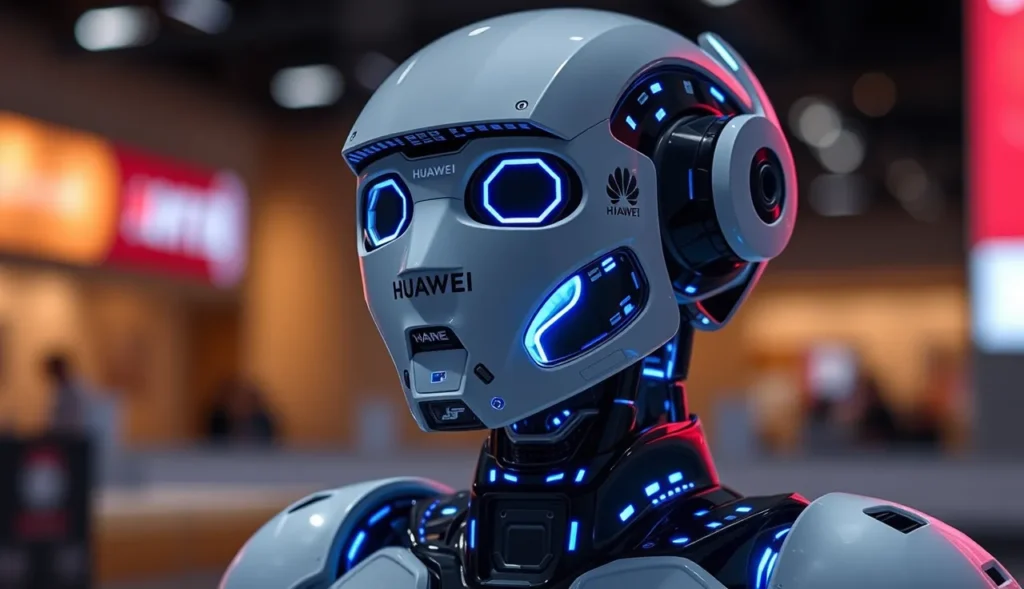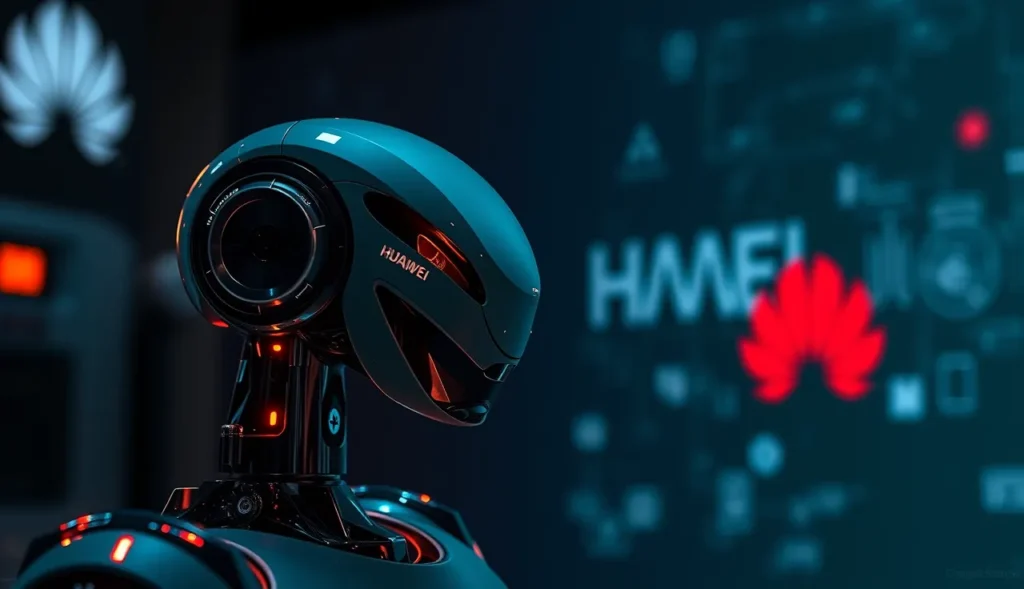
The AI landscape is a battlefield, with Huawei emerging as a formidable player against U.S. and European tech titans. The race for dominance is reshaping industries, policies, and global strategies.
How does Huawei stack up?
Huawei’s Ambitions in the AI Revolution
Huawei’s Vision for AI Leadership
Huawei has made AI innovation central to its growth. Its mission? Build a global AI ecosystem that drives technological empowerment.
The company’s flagship platform, MindSpore, rivals systems like Google’s TensorFlow, offering streamlined AI deployment for businesses. By focusing on integration across devices, Huawei is positioning itself as a one-stop AI shop.
Moreover, Huawei’s research and development investments, exceeding $23 billion in 2023 alone, signal its serious commitment to AI.
Focus on Edge Computing and IoT
Unlike many competitors, Huawei leans heavily on edge computing—bringing computation closer to data sources.
- This enables faster processing.
- Enhances real-time capabilities.
- Supports smart IoT devices, from homes to cities.
Through partnerships with global telecom leaders, Huawei has made its AI solutions vital for smart infrastructure projects worldwide.
How Huawei Challenges U.S. Giants
Competing with Google and Microsoft
The U.S. leads in cloud AI services with platforms like Google Cloud AI and Microsoft Azure. Huawei counters this with Huawei Cloud, offering competitive pricing and advanced AI-as-a-Service solutions.
Its advantage lies in Asia-Pacific dominance, where Huawei Cloud outpaces U.S. offerings in adoption. Huawei’s ability to integrate hardware and software seamlessly challenges the modular approach of its rivals.
Adapting to U.S. Sanctions
The U.S.-China trade war introduced export restrictions targeting Huawei’s access to cutting-edge chips and software. Yet, Huawei turned adversity into opportunity by investing heavily in semiconductor independence.
Its Kirin processors now rival Nvidia and AMD in AI workloads, showcasing Huawei’s resilience and innovation under pressure.
Huawei vs. European Giants in AI

Competing with Siemens and Bosch
European firms like Siemens focus on industrial AI—predictive maintenance, robotics, and manufacturing solutions. Huawei, however, blends AI with 5G networks, creating end-to-end solutions for industries and cities.
This unique offering positions Huawei ahead in markets demanding connectivity-driven AI solutions, particularly in Asia and Africa.
Battling Regulatory Hurdles
The EU’s stringent regulations on AI and data privacy create barriers for Huawei. Unlike U.S. companies, which are often more agile, Huawei faces higher scrutiny over data security concerns.
Despite this, Huawei is advancing by emphasizing data localization and compliance with GDPR standards, aiming to build trust in European markets.
Innovations Setting Huawei Apart
A Unique Hardware-Software Synergy
Few companies can match Huawei’s ability to integrate hardware and AI software. Its AI chips power flagship platforms, reducing reliance on third parties.
For example, the Ascend AI processor series leads in energy efficiency and scalability, offering unparalleled performance for enterprise AI applications.
Investment in AI Talent and Ecosystems
Huawei’s global training programs, like the Seeds for the Future initiative, cultivate AI expertise worldwide. This talent pipeline reinforces its competitive edge while fostering goodwill in emerging markets.
Strategic Alliances and Expansion in Emerging Markets
Huawei’s Focus on Developing Economies
Huawei has carved a niche in emerging markets like Africa, Southeast Asia, and Latin America. While U.S. and European firms often prioritize developed economies, Huawei’s affordable AI solutions and robust 5G infrastructure make it a go-to partner in these regions.
Its work in smart cities, agricultural AI, and educational tech demonstrates how Huawei is enabling transformation in areas overlooked by larger competitors. This strategy strengthens its foothold globally and opens doors to untapped growth opportunities.
Collaborations with Governments and Academia
Huawei fosters public-private partnerships, often collaborating with governments to integrate AI into public services. By teaming up with universities worldwide, Huawei is also funding AI research and talent development, further embedding itself in local ecosystems.
Overcoming Trust Deficits in New Markets
Though Huawei faces geopolitical mistrust, especially in Western countries, its efforts to promote transparency in emerging economies are reshaping perceptions. Initiatives like open AI research and localized solutions build confidence among governments and consumers alike.
Ethical AI Development: Huawei’s Balancing Act

Aligning with Global Ethical Standards
Huawei’s AI initiatives emphasize fairness, transparency, and inclusivity, aligning with global calls for responsible AI. Through adherence to UN sustainability goals, Huawei ensures its AI serves a greater societal good, from environmental conservation to healthcare accessibility.
Tackling Privacy and Surveillance Concerns
One of Huawei’s most significant challenges lies in addressing data privacy fears. Western nations often criticize its close ties to the Chinese government. To combat this, Huawei has ramped up data encryption efforts and emphasizes sovereign AI frameworks that allow countries to control their data fully.
While trust-building remains an uphill battle, Huawei’s proactive measures showcase its commitment to operating ethically.
The Road Ahead: Huawei’s Competitive Prospects
Shaping the Future of AI Competition
Huawei’s strategic investments, resilience in the face of sanctions, and emphasis on emerging markets position it as a formidable competitor. As global AI regulation evolves, Huawei’s focus on adaptability and innovation could be its key to enduring success.
By bridging gaps between cutting-edge tech and real-world applications, Huawei challenges the dominance of U.S. and European tech giants in meaningful ways.
The Geopolitical Landscape: Challenges for Huawei
U.S. Sanctions and Strategic Decoupling
The U.S.-China rivalry has led to sweeping sanctions on Huawei, targeting its access to advanced chips and software. These restrictions are designed to stymie Huawei’s growth in AI, forcing the company to pivot toward domestic innovation.
Huawei’s response has been bold. Its HiSilicon chips, built on domestically developed processes, demonstrate significant progress despite external constraints. Still, the lack of access to cutting-edge 5nm or 3nm chips remains a stumbling block.
Europe’s Careful Balancing Act
European nations find themselves in a precarious position. On the one hand, the EU values transatlantic cooperation and shares concerns about Huawei’s ties to the Chinese government. On the other, Huawei’s affordable and efficient AI solutions are vital to its digital transformation goals.
Countries like Germany and Italy adopt hybrid policies, allowing Huawei to compete in limited capacities, particularly in non-sensitive sectors. This cautious approach reflects Europe’s struggle to balance security concerns with economic opportunities.
Huawei’s Soft Power Strategy
To counter geopolitical headwinds, Huawei employs soft power tactics, such as:
- Educational partnerships to develop AI skills in underrepresented regions.
- Sponsorships and philanthropy to improve its global image.
- Promoting AI for sustainability and humanitarian goals, which resonates with international audiences.
These efforts aim to foster goodwill and weaken the narrative of Huawei as a national security threat.
AI Regulations: Navigating a Complex Framework
The Impact of Global AI Policies
As nations draft AI regulations, Huawei faces an increasingly complex environment.
- The U.S. and EU focus on AI transparency and accountability.
- Emerging economies emphasize AI adoption and growth, with fewer restrictions.
Huawei’s adaptability to local frameworks is critical. Its investments in compliance systems allow the company to tailor its offerings while addressing regulatory requirements.
GDPR and Ethical AI Compliance
In Europe, Huawei aligns its AI solutions with GDPR guidelines, ensuring data privacy and security. By emphasizing compliance, Huawei hopes to overcome resistance in markets wary of Chinese tech.
Additionally, Huawei’s commitment to ethical AI includes partnerships with AI ethics organizations and developing tools for algorithmic fairness, further showcasing its proactive stance.
Huawei’s Position in the AI Ecosystem
Strengths: Integration and Affordability
Huawei’s ability to seamlessly integrate hardware, software, and AI is unmatched. This holistic approach allows it to deliver cost-effective solutions, particularly in sectors like:
- Healthcare AI, improving diagnostics and patient outcomes.
- Logistics AI, optimizing supply chains for efficiency.
- Energy AI, advancing sustainable power management.
Weaknesses: Trust and Technological Gaps
Despite its strengths, Huawei faces hurdles, including:
- Limited access to advanced chips due to sanctions.
- Persistent trust deficits in Western markets.
Overcoming these weaknesses requires a blend of technological breakthroughs and global trust-building campaigns.
The Future of the AI Race
Huawei’s Long-Term Strategy
Huawei’s success hinges on its ability to diversify and innovate. By expanding its presence in emerging markets, investing in AI ecosystems, and maintaining leadership in 5G integration, Huawei can sustain its momentum.
Meanwhile, semiconductor independence remains a top priority. If Huawei achieves breakthroughs in chip technology, it could reshape the global AI hierarchy.
The Global Stakes of the AI Race
As AI becomes the cornerstone of global innovation, Huawei’s competition with U.S. and European giants isn’t just about market dominance—it’s about shaping the future of technology and geopolitics. The race remains unpredictable, but Huawei’s resilience ensures it won’t be counted out anytime soon.
Conclusion
Huawei’s journey in the AI race showcases its blend of ambition, innovation, and adaptability. Despite facing sanctions, regulatory hurdles, and trust issues, Huawei continues to innovate and expand, particularly in emerging markets. Its ability to thrive in adversity may very well determine its long-term position against U.S. and European competitors.
As the AI landscape evolves, the world will watch closely to see if Huawei can maintain its momentum and truly redefine global AI leadership.
FAQs
How does Huawei’s AI strategy differ from U.S. and European competitors?
Huawei emphasizes integration across hardware and software platforms to offer a seamless experience. For instance, its Ascend AI processors work hand-in-hand with the MindSpore AI framework, making deployment faster and more efficient.
In contrast, U.S. giants like Google focus heavily on cloud-based AI, and European firms like Siemens lean toward industrial AI solutions.
What are Huawei’s key innovations in AI?
Huawei has pioneered several innovations, including:
- Edge computing solutions: These enable faster AI processing for IoT devices, like real-time data analytics in smart cities.
- AI-powered 5G networks: Huawei integrates AI to optimize signal efficiency and network coverage.
These advancements have set Huawei apart, especially in markets with high connectivity demands.
How does Huawei address data privacy concerns?
To build trust, Huawei adheres to GDPR standards in Europe and emphasizes data localization in various markets.
For example, in Africa, Huawei provides AI solutions where sensitive data remains stored within the country, giving governments full control. This approach reduces fears around data sovereignty and security.
Why is Huawei’s role in emerging markets significant?
Emerging markets often lack access to affordable and scalable AI solutions. Huawei steps in by providing:
- AI-based agricultural tools: Helping farmers optimize yields.
- Smart education platforms: Enabling remote learning in underserved areas.
This focus helps Huawei create goodwill while expanding its market footprint.
Can Huawei compete without access to advanced U.S. chips?
Huawei’s investments in semiconductor independence, such as its Kirin and Ascend processors, showcase its ability to innovate despite sanctions.
While it still lags behind U.S. giants like Nvidia in cutting-edge chip technology, Huawei’s resilience ensures it remains competitive in most markets.
What challenges does Huawei face in the AI race?
Huawei’s primary challenges include:
- Geopolitical mistrust, especially in Western countries.
- Chip shortages due to sanctions limiting access to advanced technology.
However, Huawei counters these issues with aggressive R&D investments and a focus on emerging markets less influenced by geopolitics.
How does Huawei contribute to AI ethics?
Huawei actively promotes ethical AI development by:
- Partnering with global AI ethics organizations.
- Developing transparent algorithms to reduce bias.
For example, Huawei’s AI-powered healthcare tools emphasize equitable diagnostics across different demographics, ensuring fairness in medical outcomes.
What is the future outlook for Huawei in the AI industry?
Huawei’s future depends on its ability to:
- Advance its semiconductor technology.
- Expand its influence in less-regulated markets.
- Maintain its leadership in 5G-integrated AI solutions.
Its success in building trusted partnerships with governments and businesses will be crucial to sustaining its momentum in the AI race.
Resources
Huawei’s Official Platforms
- Huawei’s AI Solutions: The official Huawei website provides detailed insights into its AI technologies, including MindSpore and Ascend processors.
- Huawei Cloud AI: Learn more about Huawei’s cloud-based AI services and their applications in various industries.
Industry Analysis and Reports
- McKinsey & Company AI Insights: Explore McKinsey’s reports on the global AI landscape, including Huawei’s positioning.
- IDC Reports on AI: Regular updates on AI market trends, highlighting Huawei’s growth and innovations.
- Gartner Research: Analysis of Huawei’s competitive advantages and challenges in the AI sector.
Academic and Policy Resources
- European Commission’s AI Regulation Framework: Understand the regulatory challenges Huawei faces in Europe.
- Harvard Business Review on AI Strategy: Comprehensive articles on global AI strategies, including comparisons between Huawei, U.S., and European companies.
News and Geopolitical Insights
- Reuters Technology News: Stay updated on the latest developments regarding Huawei and AI.
- The Economist on AI Innovation: In-depth coverage of geopolitical issues and technological advancements in AI.
- BBC News on Huawei: A reliable source for unbiased reporting on Huawei’s challenges and achievements.
Specialized AI and Tech Blogs
- AI Trends: Insights into cutting-edge AI advancements, including Huawei’s contributions.
- TechCrunch: Covers innovations from Huawei and other major AI players.
- VentureBeat: Offers analysis of AI strategies from companies like Huawei, Google, and Siemens.